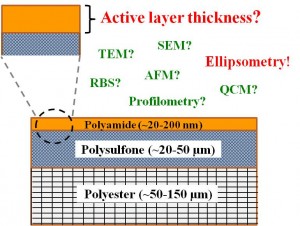Lin Lin’s paper entitled “Identifying facile and accurate methods to measure the thickness of the active layers of thin-film composite membranes – A comparison of seven characterization techniques” is published in the Journal of Membrane Science. This is the first study that comprehensively compares various methods commonly used to measure active layer thickness (i.e., transmission electron microscopy, scanning electron microscopy, atomic force microscopy, Rutherford backscattering spectroscopy) as well as three non-commonly used methods (i.e., ellipsometry, profilometry, and quartz crystal microbalance). The results indicate that electron microscopy methods provide thickness values that are significantly larger than results provided by the non-electron microscopy techniques, and therefore should be used only when rough estimates of thickness are acceptable. The results obtained with the non-electron microscopy techniques were generally in agreement with each other. On the basis of nine different factors used to evaluate the advantages and disadvantages of the seven different methods tested, ellipsometry was found to be the most advantageous methods. This paper can be accessed at http://dx.doi.org/10.1016/j.memsci.2015.09.059 (Journal of Membrane Science. 2016, 497, 365-376).


University Operator: (919) 962-2211 | © 2024 The University of North Carolina at Chapel Hill |